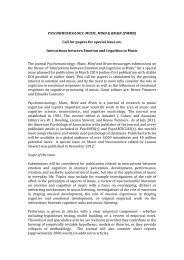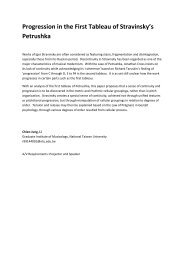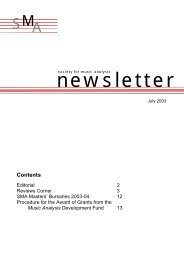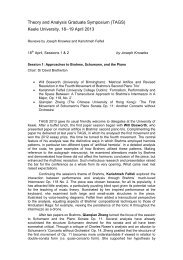Newsletter No. 31 (January 2009) (PDF) - Society for Music Analysis
Newsletter No. 31 (January 2009) (PDF) - Society for Music Analysis
Newsletter No. 31 (January 2009) (PDF) - Society for Music Analysis
Create successful ePaper yourself
Turn your PDF publications into a flip-book with our unique Google optimized e-Paper software.
developmental techniques. Most of thepaper was devoted to presenting the graphicresults of a broadly Schenkerian analysis ofthe variations in the second movement andexhibited a strong reading of themovement‟s resolution and rhythmic closure.Questions included an observation by JulianHorton about the use Schubert makes oftexture as part of a diminution variationscheme, and how this might relate toHyland‟s pitch- and rhythm-centred reading.Michael Spitzer, noting that the use of ^5 invariation themes is quite common in Haydnand Mozart, especially when leftuncompleted as a promissory note <strong>for</strong> laterworking through in the variations, askedwhat made this particular theme‟s ^5special, suggesting that it might be preciselythe lack of ^4 in the musical text andHyland‟s analytical reduction.David Bretherton (Southampton) and BlakeHowe (CUNY) presented on, respectively,„Evocation through Structure in Schubert‟s„Gondelfahrer‟‟ and „On Annihilation andTranscendence: Schubert‟s Final MayrhoferSettings‟. Both speaking about Schubert‟sMayrhofer settings, there were somefascinating interactions between their twoarguments. Bretherton presented acomparative reading of D808 and D809, thelatter being a four-part male chorus recompositionof the <strong>for</strong>mer. Discussing thequite substantial changes Schubert effectedin D809, and invoking a particular moment inEuropean history, Bretherton was able topresent a good case <strong>for</strong> D808 having beencomposed be<strong>for</strong>e D809. Moreover, heargued, the song must have presented itscontemporaries with rich and ambiguouscontent that was probably deemed toopolitically subversive to be published inSchubert‟s lifetime – most obviously in itscentral section, the A b s of which toll midnightin a chillingly symbolic piece of art imitatinglife, “marking the passage of time andcausing it”. In his paper, Howe, using threeimage schemata (separation, rupture, andtranscendence), presented a hermeneuticreading of Schubert‟s “shared intertextualmusical gestures” and cyclical intentions, inparticular the <strong>for</strong>ce that takes C to C # or D b ,and offered a sensitive reading of„Auflösung‟ that paid due attention to the useof register. He also proposed a re-orderingof the four songs D805–8 composed in early1824, based upon evidence found in thesketches.Cameron Gardner (Cardiff) talked through ahermeneutic interpretation of the A minorPiano Sonata D845, relating it motivically to„Todtengräbers Heimwehe‟ D842 andunfolding a thoughtful analysis of thenarrative structure of its first movement.Illustrating his own examples at the piano,his reading allowed <strong>for</strong> many connectionsbetween song and sonata to emerge,particularly in the motivic realm. The mainfocus of his attention was on the sonata‟scoda (and the song‟s final verse). His claim,made with reference to work by RobertHatten and Michael Klein and arguingagainst Charles Fish‟s integrative reading ofthe final three sonatas, was that Schubert‟suse of enharmonic shifts and motivicrepetition sets in motion an interpretation ofthe sonata quite different to the song, and inwhich the ending of the sonata is ultimatelynon-transcendent. Gardner noted that thisreading could be extended across the wholesonata, given the parallels with the finalmovement.With the exception of the AGM of the SMA,which had an un<strong>for</strong>tunately low turnout inthe afternoon, CarMAC had an energeticatmosphere, which I‟m sure continuedthrough Saturday and Sunday. There wascertainly plenty of evidence of vibrantcommunities of scholars working at, with,through, against, in, around, beyond, andalongside analysis.Anthony GrittenOn the train on the way to the Cardiff <strong>Music</strong><strong>Analysis</strong> Conference (CarMAC), Iexperienced a mixture of feelings. I waslooking <strong>for</strong>ward to a conference which mightnot invite one of my usual complaints: “Whatabout the music?!”. But there was also someapprehension, perhaps encouraged by thewet early autumn weather. Would I reallycall myself an „analyst‟? How would I fit inamong scholars who would call themselves„analysts‟? Such misgivings are notuncommon among research students, andindeed established academics. Andnegotiating disciplinary identity is not merelytheoretical, but raises important intellectualand practical questions. To whom is mywork addressed? Where shall I submitarticles <strong>for</strong> publication? What jobs can Iapply <strong>for</strong>? And – of course – whichconferences should I attend?My fears proved unfounded. The sea ofhopelessly impenetrable and unnecessarilycomplex <strong>for</strong>ms of verbal and diagrammaticalexpression I have sometimes associatedwith music analysis were not much inSMA newsletter 12







